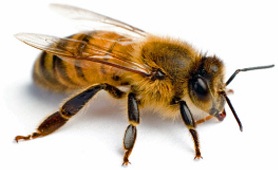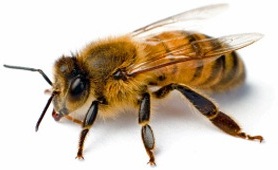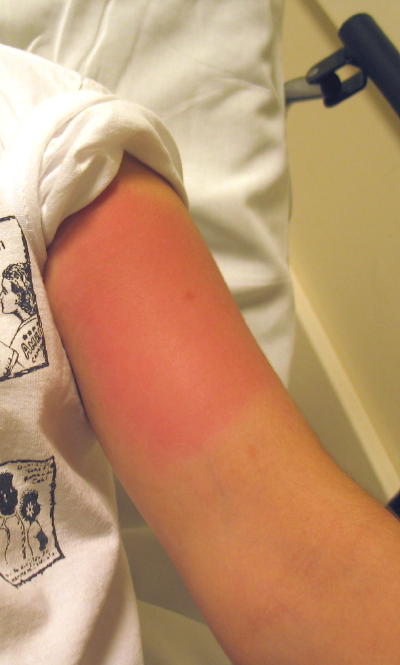

Bee Sting
symptoms, treatment, allergic reactions, learn how a bee stings


symptoms, treatment, allergic reactions, learn how a bee stings
All kinds of bees and other stinging insects including wasps fall into the phylum Arthropod category, which is a part of the Hymenoptera family. Bees are very important in many different ecosystems because they help to pollinate many different kinds of plants that are food to other animals.
Bees have long been a fear of many human beings for their ability to sting, and inject lethal poison into nearly any animal. The sting of a bee can range greatly in the amount of pain felt depending on the type of bee that you are stung by. The sting of a bee feels much like a pinpointed pinch, and is often a very local pain.

Almost immediately after the sting, you will notice that the area around the sting will turn red, and the area may become raised and sore to the touch. These symptoms can last up to 48 hours, with a dying-down during the second half of the period. Depending on the reaction that your body has to the sting, some individuals have experienced a raised portion that is wider than 12 inches in diameter. In cases like these, you could be experiencing an allergic reaction, and it is recommended that you seek medical help as soon as possible to make sure that the situation does not worsen.
The average person can withstand one bee sting for every pound of body weight, as long as they do not have any adverse reactions to the sting. This means that approximately 1000 bee stings could kill the average sized adult male, while only 500 stings could potentially kill a small child. To receive that many stings, you would likely have to upset a nest of some kind, and be swarmed by a large amount of bees. Most stinging insects that are a part of the same family as bees will die after they sting you, but a number of insects that belong to the family will not die after the initial stinging and may be able to sting you several times.

If you are allergic to a bee sting, you should notice an allergic reaction within the first hour after being stung. Most have been led to believe that it may take several stings for you to notice an allergic reaction, but this is not necessarily true. Individuals that are allergic to bee stings will likely notice the effects after the first sting, and within the first hour after being stung.
Having an allergy to bee stings could place a person in anaphylactic shock, which is a very dangerous condition that could potentially kill. Those that are most at risk as a result of an allergic reaction to bee stings are young children and elderly adults, although they have typically been known to have less severe reactions to bee stings.
Other symptoms that are commonly associated with a bee sting will include itching at the site of the sting, and a bacterial skin infection. Although these infections are quite uncommon, you could notice one developing in the first 24 hours after being stung. Some infections have been known to take as long as 36 hours to set in.
Allergic reactions are characterized by the appearance of hives, which are raised bumps all over the body and can be very itching. You may also notice that your mouth or throat swell quite a bit, which can inhibit breathing and requires that you seek immediate medical attention. You may also experience nausea, vomiting and chest pain during allergic reactions. If you experience any of these symptoms, or difficulty breathing and unconsciousness, it is important that you seek medical help from a professional as soon as possible, especially if it is your first time being stung by a bee.
Luckily, the reactions to a bee sting are usual very easy to identify, and someone who knows that they are allergic to bee stings should be able to get moving toward medical treatment as soon as they have identified that they have been stung. Although on the larger scale bee stings are not that dangerous, they can become very dangerous if an allergic reaction is left untreated and the individual goes into anaphylactic shock, which can result in death.